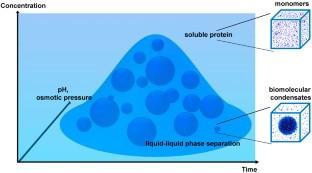Biochemistry (Moscow) ( IF 2.8 ) Pub Date : 2024-03-08 , DOI: 10.1134/s0006297924140116 Natalia A. Gorsheneva , Julia V. Sopova , Vladimir V. Azarov , Anastasia V. Grizel , Aleksandr A. Rubel

|
Abstract
The term “biomolecular condensates” is used to describe membraneless compartments in eukaryotic cells, accumulating proteins and nucleic acids. Biomolecular condensates are formed as a result of liquid–liquid phase separation (LLPS). Often, they demonstrate properties of liquid-like droplets or gel-like aggregates; however, some of them may appear to have a more complex structure and high-order organization. Membraneless microcompartments are involved in diverse processes both in cytoplasm and in nucleus, among them ribosome biogenesis, regulation of gene expression, cell signaling, and stress response. Condensates properties and structure could be highly dynamic and are affected by various internal and external factors, e.g., concentration and interactions of components, solution temperature, pH, osmolarity, etc. In this review, we discuss variety of biomolecular condensates and their functions in live cells, describe their structure variants, highlight domain and primary sequence organization of the constituent proteins and nucleic acids. Finally, we describe current advances in methods that characterize structure, properties, morphology, and dynamics of biomolecular condensates in vitro and in vivo.
中文翻译:

生物分子凝聚体:结构、功能、研究方法
摘要
术语“生物分子凝聚物”用于描述真核细胞中积累蛋白质和核酸的无膜区室。生物分子缩合物是液-液相分离(LLPS)的结果。通常,它们表现出液体状液滴或凝胶状聚集体的特性;然而,其中一些可能看起来具有更复杂的结构和高阶组织。无膜微区室参与细胞质和细胞核中的多种过程,其中包括核糖体生物发生、基因表达调节、细胞信号传导和应激反应。凝聚体的性质和结构可能是高度动态的,并受到各种内部和外部因素的影响,例如组分的浓度和相互作用、溶液温度、pH、渗透压等。在这篇综述中,我们讨论了各种生物分子凝聚体及其在活体中的功能细胞,描述其结构变体,突出显示组成蛋白质和核酸的结构域和一级序列组织。最后,我们描述了表征体外和体内生物分子凝聚物的结构、性质、形态和动力学的方法的最新进展。



























 京公网安备 11010802027423号
京公网安备 11010802027423号